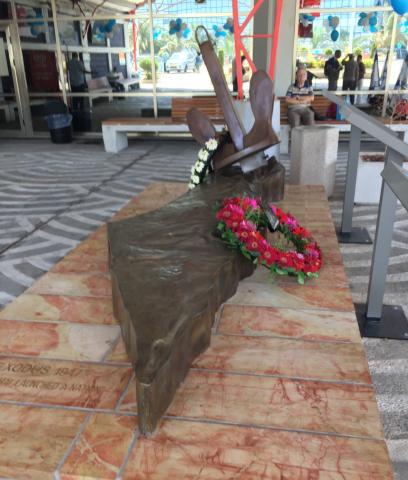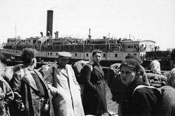Aliyah Bet & Machal Virtual Museum
North American Volunteers In Israel's War of Independence
Honoring The Ship That Launched A Nation

By Daniel Fliegler
The elderly man recounted how as a child on board the Exodus 1947 he could see the port of Haifa and the Carmel mountains in the distance. Being so close to Israel he was filled with joy, but the men next to him started to cry. He asked them why were they crying. The reply was that they would be forced to go to Cyprus. Yet the knowledge was there that they would return. No one on that ship knew the future events that would lead to their return and how their determination to return would set into motion the final steps for the United Nations recognition of the Jewish state.
This was elaborated in Haifa port on July 18, 2017, seventy years to the day that the British brought the Exodus 1947 to this port after capturing her. Now on this fateful day a fitting memorial was dedicated to this event with an appropriate ceremony.
After the Second World War, the Jewish survivors of the Holocaust wanted to leave Europe and come home to Israel which was then called Palestine. The British controlled the area through its League of Nations Mandate. It was the British intention to keep control of Palestine as a necessary step for the preservation of their empire. Thinking it more expedient to appease the Arabs, the British through its 1939 White Paper forbade the immigration of Jews into Palestine except for a monthly quarter of 1500. The Jews of Palestine through the Jewish Agency and the underground armies of the Hagana, Irgun, and Lehi brought in Jewish refugees none the less as part of a movement called Aliyah Bet. Since 1946, surplus war ships were brought cheaply in the United States and Canada. They were manned by crews consisting mostly of Jewish volunteers. The ships would sail from the US pick up hundreds and thousands of refugees waiting in Europe and continue onward to Palestine. The British navy succeeded in capturing most of the ships. British policy was to intern the refugees in camps in Cyprus. The Exodus 1947 was to be different. Formally called the President Warfield, it was originally a pleasure boat transporting passengers and freight between Norfolk and Baltimore. It saw action in WWII with first the British and then the US navy being stationed off Normady, France. It returned to the US and was sold to a dummy company of the Hagana for scrap. The ship was taller than the average British warship making it harder to be boarded and seized by British Royal Marines. The plan was to openly land the refugees in Palestine in defiance of the British navy. With a stroke of genius Moshe Sneh head of immigration in the Jewish Agency came up with the name Exodus 1947 So the ship picked up 4515 refugees in Marseilles and headed to Palestine with the British shadowing it. Two British destroyers rammed the Exodus and the marines managed to board the ship. On the ship, the marines were met with stiff resistance by the refugees who threw everything including potatoes at them. Three people were killed as a result of the assault. One of them was Bill Bernstein an officer on the Exodus who tried to prevent the marines from capturing the wheelhouse which controlled the ship. Instead of being interned in Cyprus the refugees were imprisoned like animals and sent to France. The refugees refused to disembark in France and the French authorities refused to force them. The British decided to send the refugees to Germany and force them to disembark there. Expecting negative publicity, the British were totally unprepared for the firestorm of condemnations that followed. Reports by journalist Ruth Gruber and eyewitness accounts by the Reverend John Grauel who sailed on the Exodus as an official observer convinced the United Nations that this state of affairs could not continue. On November 29 of that same year the United Nations voted in favor for the establishment of the Jewish state. The Exodus 1947 truly earned its nickname as ‘the ship that launched a nation.
Jerry Klinger, president of the Jewish American Society for Historic Preservation, learned that there were monuments for the Exodus 1947 in Italy, Germany, France, and the US but none in Israel where the main historical events occurred. It is entirely due to Klinger’s efforts that a monument now stands in the port of Haifa where the ship was taken to by the British. The monument, sculpted by Sam Philipe consists of an anchor behind or ‘launching’ a three dimensional map of Israel. A fitting monument for ‘The ship that launched a nation’. The ceremony was most fitting going on for hours. Speaker after speaker spoke of their connection to Exodus, while on a screen behind the podium were video clips of the ship and the land of Israel. One of the most moving connections of the Exodus came from Natan Sharansky, former refusenik and now chairman of the Jewish Agency. When he was a refusenik in the former USSR, Sharansky would ask visitors to bring with them copies of the novel Exodus. Although the novel gave the story of a different Aliyah Bet ship it still had an impact on the refuseniks in their struggle to maintain their Jewish identity. In an irony of history, most of the American volunteers for the Aliyah Bet crews kept their involvement a secret for fear of criminal prosecution by the US government. At the ceremony, was Michael Snowden representing US Ambassador Friedman proudly recounting that most of the Exodus crew were American.
Singing icons Noy Sassover and Shuli Natan sung song after song with Natan including her famous renditions of Jerusalem of Gold and Captain My Captain.
Representing American Veterans of Israel Legacy Corp were, Donna Parker, Jerry Klinger, and this writer.
Also See
- Log in to post comments

 Back to News
Back to News


 Contact Us
Contact Us
 In a personal essay, Aliyah Bet and Machal Archives Director Ralph Lowenstein discusses the reasons why so few persons have ever heard of the thousand or so volunteers from North America who played a role in the winning of the War of Independence.
In a personal essay, Aliyah Bet and Machal Archives Director Ralph Lowenstein discusses the reasons why so few persons have ever heard of the thousand or so volunteers from North America who played a role in the winning of the War of Independence.